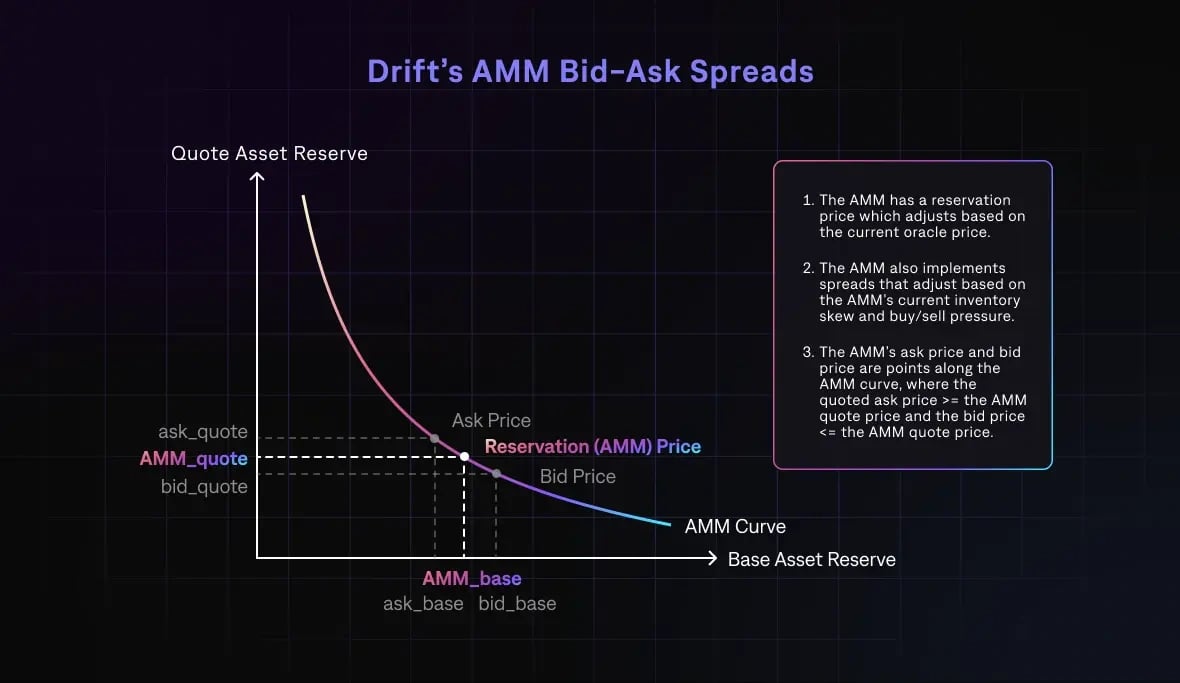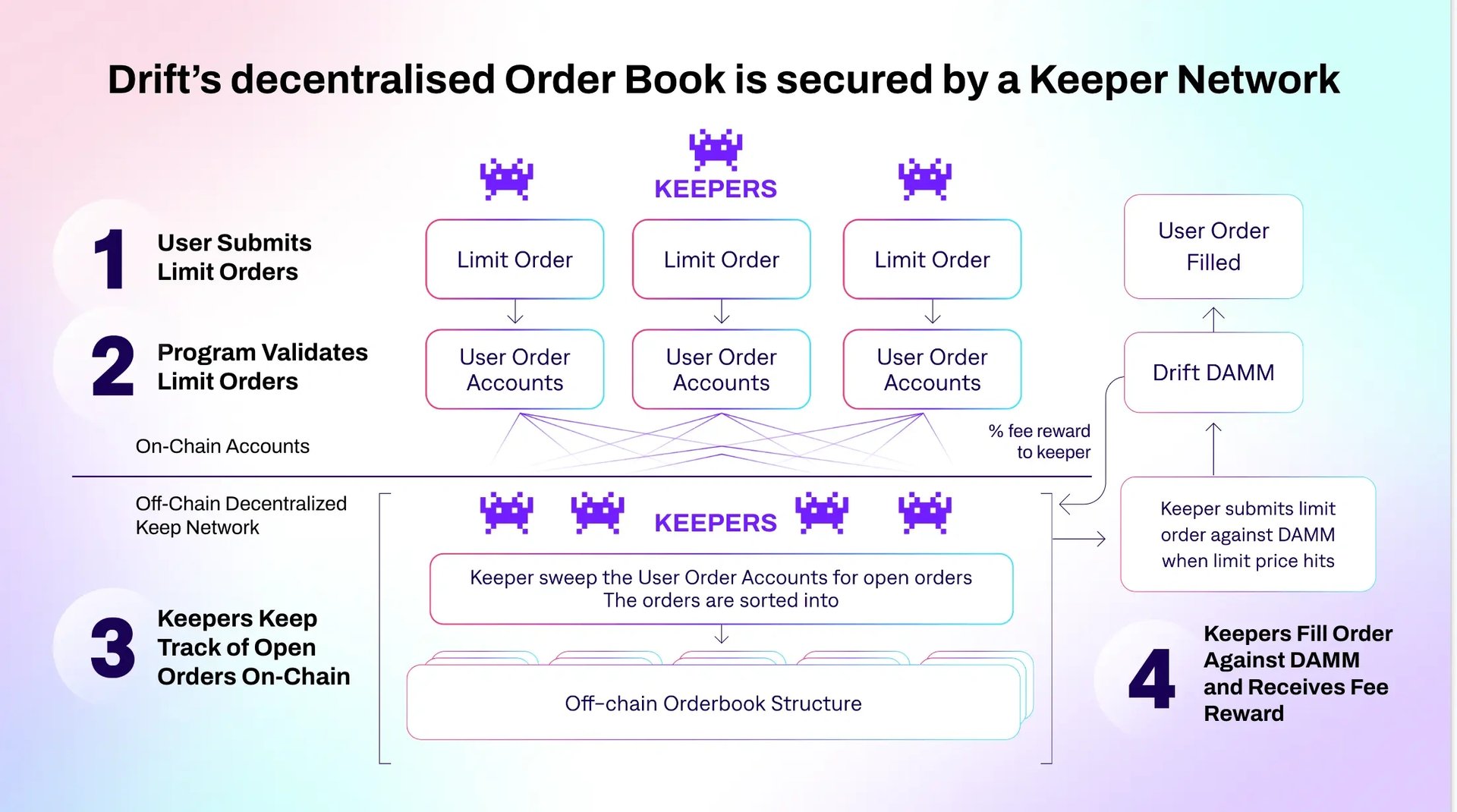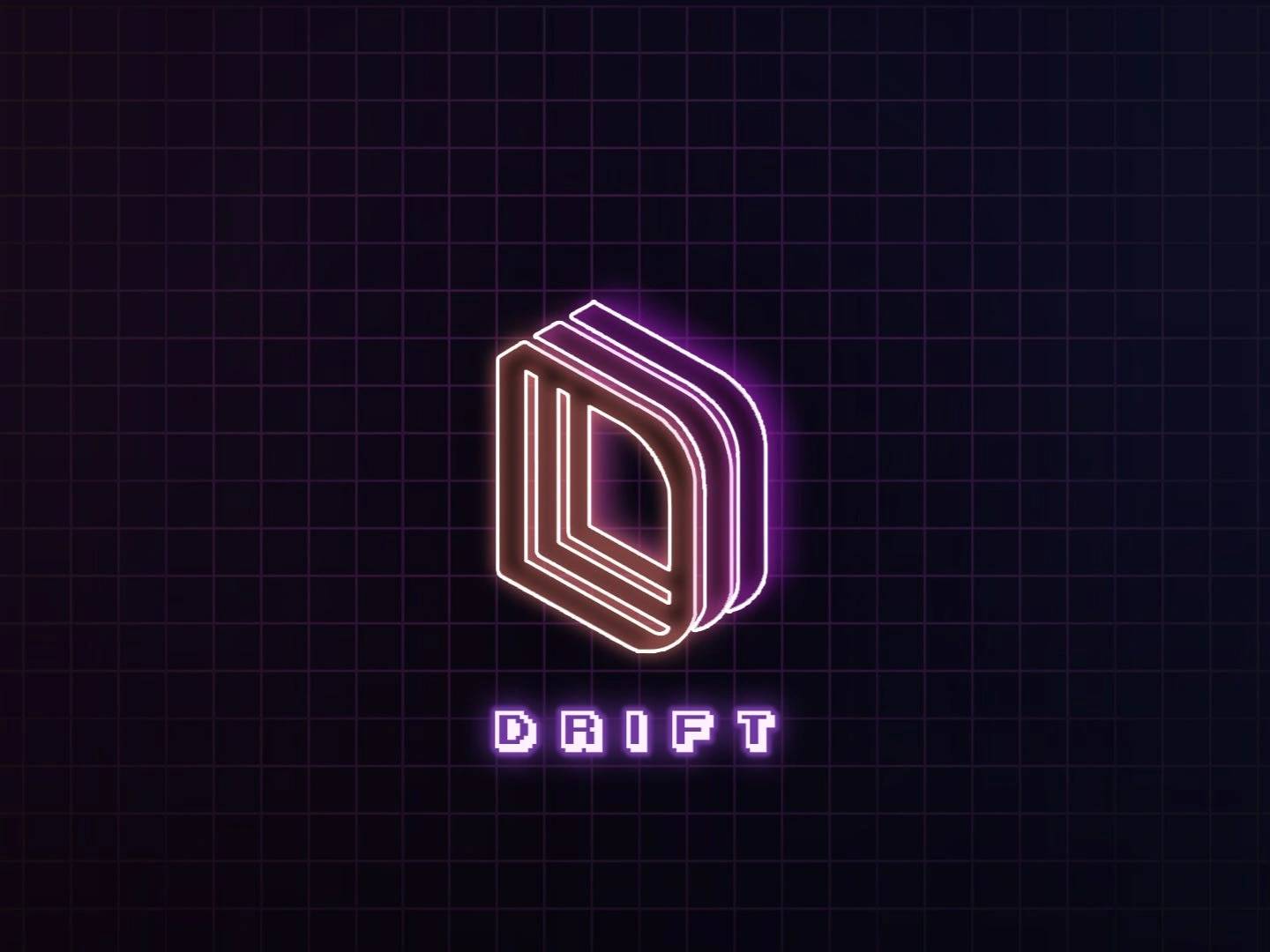Subscribe to wiki
Share wiki
Bookmark
Drift
The Agent Tokenization Platform (ATP):Build autonomous agents with the Agent Development Kit (ADK)
Drift
Drift is a decentralized trading and staking platform built on the Solana blockchain, offering perpetual futures, spot trading, and liquid staking. It integrates an on-chain orderbook with automated market-making to facilitate efficient, low-latency trading and optimized capital utilization. [1]
Overview
Drift Protocol functions as a decentralized exchange (DEX) on Solana, supporting various on-chain trading activities, including spot trading, perpetual futures, lending, borrowing, and passive liquidity provision. The protocol aims to overcome common limitations of on-chain exchanges, such as slow transaction speeds, low liquidity, and wide bid-ask spreads, by employing a combination of liquidity mechanisms and optimizing for computational efficiency.
To ensure robust liquidity for trades, Drift utilizes three primary mechanisms: Just-in-Time (JIT) auctions, where market makers compete to fulfill orders in real-time; a decentralized limit orderbook (DLOB), which is managed by external bots; and a virtual Automated Market Maker (AMM) that serves as a backstop liquidity provider when other sources are unavailable. The AMM operates based on a constant product formula and dynamically adjusts its spreads in response to its inventory. Concurrently, Keeper bots play a crucial role in managing and triggering on-chain limit orders, responding to prevailing market conditions and oracle data. As a fully on-chain protocol, Drift requires self-custodial Solana wallets for all transactions, ensuring transparency through smart contract execution while also being subject to the inherent constraints of decentralized infrastructure. [2]
Technology
Drift AMM

Drift Protocol incorporates a backstop Automated Market Maker (AMM) to provide continuous on-chain liquidity. The initial version of Drift's AMM, building upon the virtual AMM (vAMM) model, featured configurable parameters such as a price multiplier (peg), liquidity depth (k), a fee pool funded by taker fees, and dynamic fee allocations for operations like peg adjustments, liquidity tuning, and capped funding payments. [3]
The current version 2 AMM maintains a constant product formula while introducing external Backstop AMM Liquidity (BAL), a concentration factor, and dynamic spread and peg mechanisms. These mechanisms adjust in real-time based on inventory levels and oracle data. The AMM quotes distinct bid and ask prices that vary with market conditions, dynamically adjusts spreads to account for inventory imbalances, and updates its reservation price using live oracle feeds. This design ensures more responsive pricing and closer alignment with external market prices, all while maintaining decentralized execution. [3]
Decentralized Orderbook
Drift's decentralized orderbook (DLOB) operates through a hybrid system that combines off-chain Keeper Bots with on-chain settlement. These Keeper Bots continuously monitor the orderbook and facilitate order matching once specific conditions are met. This includes matching taker auctions, executing limit orders, and interacting with Drift's AMM. While two post-only maker orders cannot directly cross, market orders can trigger limit orders via a Just-in-Time (JIT) auction. However, maker orders filled by the AMM are not eligible for rebate rewards. [5]
Keeper Bots are incentivized to provide optimal execution relative to the oracle price and to adhere to a first-come-first-served execution order. Although a robust Keeper network enhances the system's performance and usability, the protocol's core functionality remains operational even if only general trading bots fulfill the Keeper role. The DLOB's design prioritizes decentralization by allowing anyone to run Keeper Bots. It achieves computational efficiency by processing complex order-filling logic off-chain, with on-chain execution triggered only when necessary. [5]
Keepers

Keeper Bots are essential components of Drift's decentralized orderbook, responsible for collecting, storing, sorting, and filling valid limit orders. They compile all open orders found on-chain into individual off-chain orderbooks, which are then organized by price, age, and, if tied, by position size. Each Keeper maintains its view of the orderbook, enabling a decentralized approach to order management. [6]
Keepers actively monitor for trigger conditions and execute trades by matching crossing orders or filling limit orders against the AMM when a user's specified trigger or limit price is met. For their services, Keepers receive a fee for each executed trade. This competitive environment incentivizes Keepers to be fast, offer superior price improvement for takers, and prioritize orders according to the protocol's desired sequence, which favors the oldest and largest orders first. [6]
Matching Engine

Drift’s matching engine employs a decentralized auction system to determine the price of taker orders. Each order is defined by configurable parameters, including auction duration, starting price, ending price, limit price, and expiration timestamp. These parameters collectively establish a linear pricing function that determines the price of an order over a specified number of time slots. Upon the completion of the auction, the limit price becomes the order's effective price. Price parameters can be set as fixed values or as offsets relative to the oracle price, allowing for adjustments based on real-time oracle fluctuations during the auction. The maximum timestamp specifies the expiration date of the order.
During its auction phase, a limit order functions solely as a taker of orders. After the auction concludes, it transitions to a "resting" state, where it can also provide liquidity as a maker, unless it is explicitly designated as "post-only." Taker orders can be filled from three distinct liquidity sources: the protocol-owned AMM (serving as backstop liquidity), existing resting limit orders, or Just-in-Time (JIT) liquidity provided by market makers specifically to fill the taker order. When an order is placed, its transaction is broadcast across the Solana network, where Keeper Bots and market makers compete to fulfill it by offering liquidity that meets the auction's criteria. The protocol prioritizes optimal price execution, evaluating the AMM's pricing against both resting and JIT liquidity for every fill attempt. [7]
Features
Insurance Fund
Drift's Insurance Fund serves as a critical safeguard for the protocol's solvency, designed to cover user bankruptcies and deficits within the Automated Market Maker (AMM). Users can stake various assets, including USDC, BTC, ETH, and SOL, into the fund. By doing so, they passively support the protocol and earn a share of the liquidation and trading fees generated, with each asset pool backing liabilities denominated in its respective currency.
The fund is activated when a user's account balance falls below zero due to unrealized losses, particularly during periods of high market volatility, and cannot be liquidated in a timely manner. It covers losses fully for spot markets and up to a predetermined cap for perpetual markets. The Insurance Fund is sustained through fees collected by the protocol and contributions from users. Any losses that exceed the fund's capacity are managed through a socialized loss mechanism. [8]
Socialized Loss
Socialized loss is a mechanism by which platform losses are distributed proportionally among all users when a market's dedicated insurance fund is insufficient to cover outstanding bad debt. This occurs if deleveraging processes fail to resolve the deficit, leading to losses being shared among open perpetual positions and lenders within the affected market. [8]
Isolated Fund
An isolated insurance fund is a separate pool of capital designated for markets deemed highly volatile, distinct from the standard insurance pool. This fund is exclusively financed by premiums collected from its specific market and is used to cover bankruptcies or leveraged losses occurring solely within that market. Any losses that exceed the capacity of an isolated fund are subsequently addressed through the socialized loss mechanism. [8]
Fuel Loyalty Program
FUEL is Drift’s on-chain loyalty program, designed to track and reward user activity across the platform. Participants earn FUEL by engaging in various actions, including staking DRIFT tokens (10 FUEL for every DRIFT staked over a 28-day period), generating taker volume (1 FUEL for every $1 in volume), and generating maker volume (1 FUEL for every $1 in volume). These earnings are continuously added to users' accounts, reflecting their total activity across all subaccounts. Time-based earnings, such as those from staking, are distributed gradually over the 28-day period.
The program also features Activity Boosters, which multiply the base earn rates for specific actions or markets. For example, a 5x booster on SOL-PERP taker volume would increase the earning rate to 5 FUEL per $1 traded while the booster is active. Information on active boosters and their rates is available on Drift’s user interface.
Season 1 of the FUEL campaign included a milestone-based distribution of up to 7.82% of the total DRIFT supply, focusing on rewarding genuine trading activity and disqualifying wash trades. Season 2 concluded in June 2025, and Drift has announced plans for future redemption options, allowing users to exchange FUEL for DRIFT tokens. This initiative aims to foster long-term community ownership and reinforce Drift’s position within the Solana DeFi ecosystem. [9]
B.E.T. Prediction Markets
B.E.T. is a capital-efficient prediction market platform built on Solana, enabling users to speculate on binary outcomes (Yes or No) for real-world events. The platform supports over 30 different collateral tokens, extending beyond just USDC, and offers advanced order types similar to those found in traditional financial markets. [10]
Users on B.E.T. can earn lending interest on all supported collateral. The platform also offers margin extension for non-USDC collateral tokens, with 0% interest until the counterparty settles any losses (realized or unrealized). Accounts collateralized solely with USDC face no liquidation risk, even in scenarios involving stablecoin de-pegging. Each account's margin requirement is calculated based on the "worst-case liability," which enhances capital efficiency compared to typical open order allocation systems. Furthermore, liquidity providers who place two-sided orders or orders that reduce risk do not require additional margin, and users can earn interest on their open orders. [10]
DRIFT
DRIFT is the native governance token of the Drift Protocol, designed to grant active users ownership and influence over the platform's future development. Holding DRIFT enables participation in the Drift DAO, where token holders can vote on critical decisions affecting the protocol. The token underpins a decentralized governance framework, aiming to align the protocol's evolution with the interests of its community by prioritizing distributed decision-making over centralized control. [4]
Tokenomics
The total supply of DRIFT governance tokens is capped at 1 billion. These tokens are planned for distribution over five years and have the following allocation: [4]
- Ecosystem & Trading Rewards: 43%
- Protocol Development: 25%
- Strategic Partnerships: 22%
- Launch Airdrop: 10%
Governance
The Drift DAO is a multi-branch governance structure that manages the evolution of the Drift Protocol. It is supported by the Drift DAO Foundation, which facilitates coordination among token holders and DAO branches. The Foundation is administered by Webslinger, a crypto advisory firm, and led by independent director Matt Shaw. DRIFT token holders participate in governance through voting, allowing them to influence core decisions related to protocol development, risk parameters, and ecosystem funding.
The DAO consists of three specialized branches. The Realms DAO oversees protocol-wide development, elects the Security Council, proposes tokenomics changes, and allocates rewards for contributions. The Security Council is responsible for adjusting protocol risk parameters, approving program upgrades, and managing the addition or removal of trading markets. The Futarchy DAO, developed in collaboration with MetaDAOProject, allocates funding for ecosystem projects using a conditional market model to inform decision-making. This structure enables a decentralized, adaptable approach to growing and securing the Drift ecosystem. [4]
Partnerships
- Ethereal Ventures
- Folius Ventures
- Anatoly Yakovenjo & Raj Gokal (Solana)
- LedgerPrime
- Bixin Ventures
- QCP Capital
- Polychain Capital
- Multicoin Capital
- Jito
- Apollo
- Securitize
See something wrong?
The Agent Tokenization Platform (ATP):Build autonomous agents with the Agent Development Kit (ADK)
